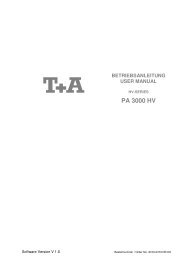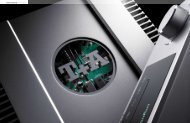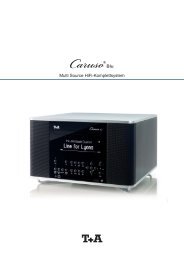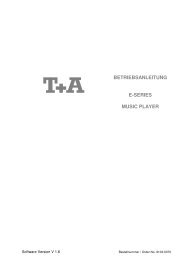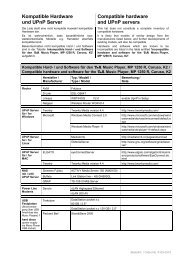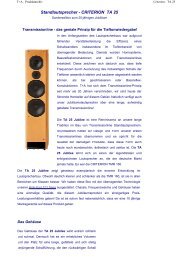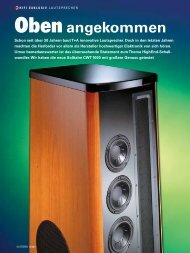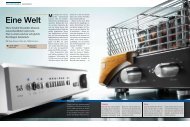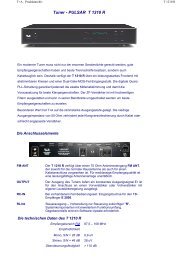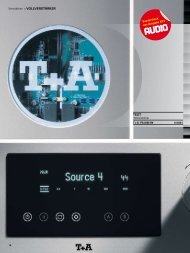CD-Player - PULSAR CD 1230 R - T+A Elektroakustik
CD-Player - PULSAR CD 1230 R - T+A Elektroakustik
CD-Player - PULSAR CD 1230 R - T+A Elektroakustik
You also want an ePaper? Increase the reach of your titles
YUMPU automatically turns print PDFs into web optimized ePapers that Google loves.
<strong>CD</strong>-<strong>Player</strong> - <strong>PULSAR</strong> <strong>CD</strong> <strong>1230</strong> R<br />
The sparkling new little brother to the <strong>CD</strong> 1240 R has everything that its sibling offers apart<br />
from the two-way converter, the co-ax output and the dual-transformer mains section. This<br />
gives us the chance to mention a few of this family’s exemplary qualities:<br />
Two Sigma-Delta stereo converters operating in double differential mode for<br />
optimum performance in terms of noise, overload and dynamics<br />
T + A reverse clock process provides 192 kHz / 24-bit resolution and eliminates jitter,<br />
driving the performance of the system close to the physical limits.<br />
As with our other <strong>CD</strong> players this unit employs a freely programmable signal processor<br />
(DSP). DSPs are not limited in the way they can process digital signals, and for this reason<br />
such a system ensures better oversampling than would be possible with standard<br />
conventional chips. Until now oversampling filters were designed to provide as smooth a<br />
frequency response as possible, but their timing characteristics (pre- and post-echo) have<br />
been neglected. The problem is long pre- and post-echo effects which can seriously distort<br />
the musical signal, especially with transients. A different type of filter is now available which<br />
exhibits perfect transient handling: these are known as polynomial filters, and unfortunately<br />
they are characterised by a slight treble fall-off at 20 kHz. In the <strong>CD</strong> <strong>1230</strong> R we employ a<br />
particular class of these filters which has been developed by <strong>T+A</strong>: BEZIER polynomial<br />
types. These are combined with an IIR filter in a three-stage oversampling process. The<br />
result is a filter which produces no pre-echos. The human ear is particularly sensitive to pre-<br />
echos for two reasons: on the one hand such an echo can never occur in the natural world,<br />
and on the other they are not concealed by the main signal, unlike post-echos. This new<br />
filter also boasts a frequency response which is considerably smoother than that of other<br />
polynomial filters (e.g. cubic spline types). Such sophisticated filters cannot be purchased<br />
ready-made, and that is why a digital signal processor is employed in the <strong>CD</strong> <strong>1230</strong> R. The<br />
freely programmable signal processor of the <strong>CD</strong> <strong>1230</strong> R is not tied to a single filter, and this<br />
makes it possible for the unit to provide five different filter types offering subtly different<br />
sound characteristics - from the classical long FIR filter via short FIR filters to the BEZIER<br />
filter. These filters can be selected by means of a button on the front panel of the unit.<br />
Connection elements<br />
Analog Out The analogue output of the <strong>CD</strong> player supplies a fixed-level<br />
output signal. It is designed for connection to a pre-amplifier,<br />
integrated amplifier or receiver with its own volume control<br />
Digital Out Optical digital output for connection to an external<br />
digital/analogue converter.<br />
Optional co-axial digital output.<br />
RC IN RC input socket for connection to an "R"-series pre-amplifier,<br />
integrated amplifier or receiver.<br />
<strong>CD</strong> <strong>1230</strong> R
<strong>T+A</strong> - Produktarchiv<br />
R-Link Interface for future system expansions<br />
Standard-filter (long FIR-filter)<br />
The long FIR-filter is the standard oversampling filter used in digital technology.<br />
Advantages: Extremely linear frequency response in the audible range, very high stop band<br />
attenuation, linear phase, constant group delay.<br />
Filter 1 (short FIR-filter<br />
The short FIR-filter has similar characteristics to the long FIR filter, but very much lower<br />
coefficient (160) and consequently considerably lower pre- and post-echoes. Advantages:<br />
Extremely linear frequency response in the audible range, high stop band attenuation, linear<br />
phase, constant group delay.<br />
Filter 2 (IIR-filter)<br />
This filter is a classic 8th order IIR-filter. It exhibits absolutely no pre-echo effects, albeit a<br />
slight tendency to post-echo. This is also a feature of natural instruments, and in any case<br />
the post-echo is usually masked by the normal audible signal. Advantages: No pre-echo at<br />
all, no treble loss, very high stop band attenuation.<br />
Filter 3 (Bezier- / IIR-filter)<br />
This combination circuit consists of three cascaded filters: a Bezier filter, an IIR filter and a<br />
second Bezier filter. It represents a good compromise between transient response and<br />
frequency response. Advantages: Virtually no pre-echo, minimal post-echo (in masking<br />
range), relatively flat frequency response, no pronounced treble loss.<br />
Filter 4 (Bezier-filter)<br />
The Bezier-filter is the ideal filter in terms of transient response, virtually no pre- or post-<br />
echo, linear phase, slight treble roll-off at 20 kHz. Advantages: Optimum transient response,<br />
linear phase, constant group delay.<br />
Specifications<br />
Mechanism Professional, close-tolerance linear disc<br />
mechanism with triple-beam LDGU optics, 780<br />
mm semi-conductor laser, 2 mW power<br />
Wow and flutter Quartz-controlled, not measurable<br />
Mechanical construction Rigid all-metal case, shielded sub-assemblies,<br />
vibration de-coupled<br />
Digital filters Freely programmable signal processor with four<br />
different filter types, 8-times oversampling and<br />
56-bit resolution, FIR short, FIR lang, IIR<br />
Bezier, Bezier IIR filters<br />
D/A converter type Double differential mode. Two 1-bit Sigma-Delta<br />
converters with 256-times oversampling<br />
Analogue filter Phase-linear Bessel filter<br />
Frequency response 2 Hz – 20 kHz<br />
Distortion / intermodulation < 0,002 %<br />
3rd order with 60 kHz limit frequency<br />
<strong>CD</strong> <strong>1230</strong> R
<strong>T+A</strong> - Produktarchiv<br />
Effective system dynamics 97 dB<br />
Signal: noise ratio (A-weighted) 109 dB<br />
Signal: noise ratio (unweighted) 106 dB<br />
Channel separation 1 kHz / 10 kHz 106 / 100 dB<br />
Digital output Data format SP-DIF<br />
1 x Opto = 660 nm / -18 dBm<br />
Analogue output nominal 2,6 V eff, 22 Ohm<br />
Dimensions 7,5 x 44 x 39 cm<br />
Weight 7 kg<br />
Colours black (9005), alu silber, chrome (non-standard<br />
version)<br />
Remote control Via R system or as non-standard version<br />
We reserve the right to alter technical specifications.<br />
<strong>CD</strong> <strong>1230</strong> R



